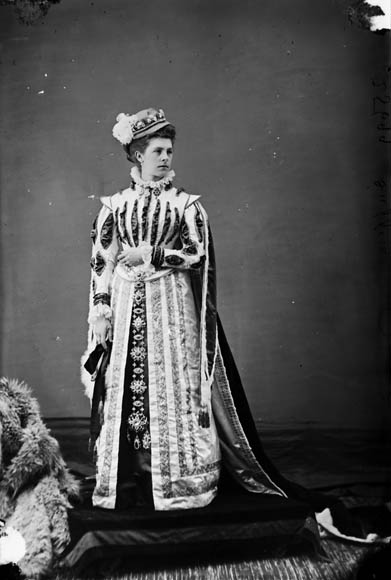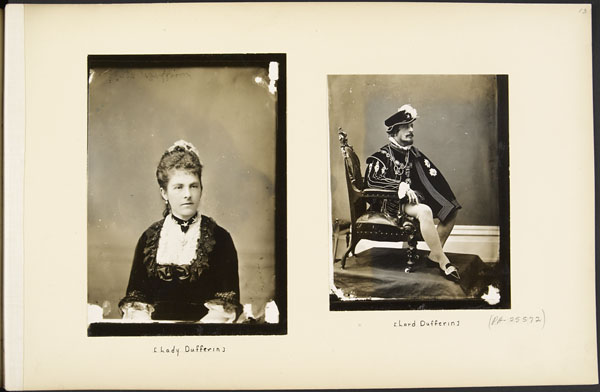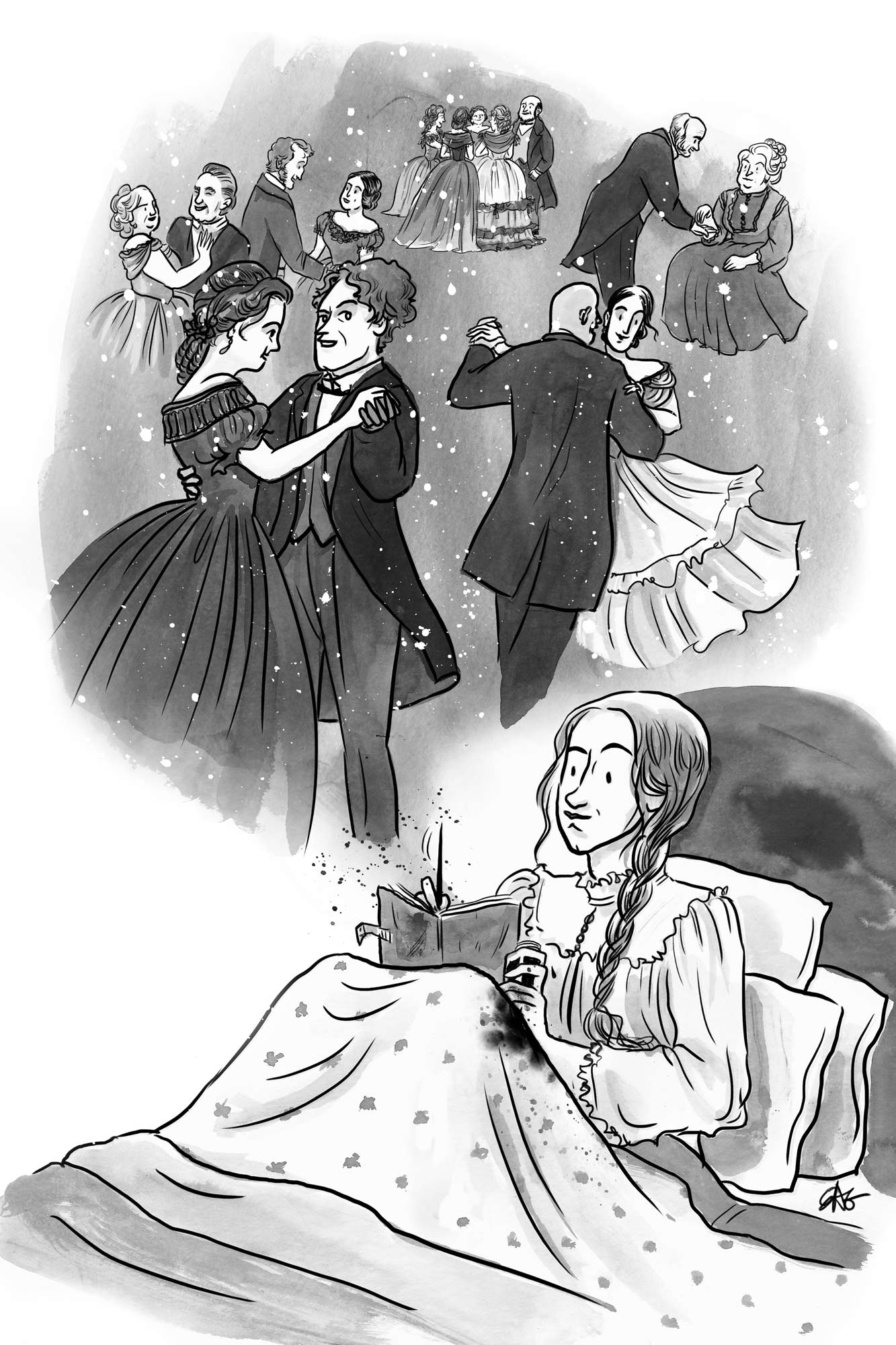Family
Born Hariot Rowan-Hamilton, Lady Dufferin was the eldest of the seven children of Archibald Rowan-Hamilton and Catherine Anne Caldwell. In 1862, Hariot was married to Frederick Hamilton-Blackwood, Baron Clandeboye, a distant cousin of her father, when Frederick was 36 and Hariot 19. They would have six sons and three daughters. Their youngest son and daughter were born in Canada.
In 1871, Frederick was elevated in the peerage as Earl of Dufferin and Viscount Clandeboye. The couple were therefore known as Lord and Lady Dufferin from that point on (including their time in Canada from 1872 to 1878).
Viceregal Consort of Canada
In 1872, Lord Dufferin was appointed Canada’s third governor general since Confederation and travelled to Ottawa with Lady Dufferin and their young family. Accustomed to Killyleagh Castle, Lady Dufferin was dismayed by her first impression of Rideau Hall, considering the residence to be “at land’s end.” She later warmed to her new home, writing, “Our house is, they say, very warm and comfortable, and the Houses of Parliament — which, after all, I do see from my windows — are very beautiful.” Lady Dufferin impressed Canadians with her dedication to her duties as viceregal consort, dignified manner and devotion to her husband and children.
As governor general, Lord Dufferin was expected to be above party politics and refrain from attending debates in the House of Commons. His wife, however, was not bound by the same expectations and observed parliamentary proceedings in the House of Commons. Lady Dufferin provided her husband with detailed accounts, including the gestures and personalities of individual politicians, thus ensuring that her husband was kept informed of Canadian political developments. (She usually attended the House with an aide to the governor general, who also reported to the GG about House matters.)
Lady Dufferin also described parliamentary affairs in letters to her mother (published in 1891 as her Canadian Journal). Her accounts included commonplace observations — “The business was not very interesting, but I was rather amused, as a number of people made very short speeches, and one saw their ‘tricks and their manners’” — as well as descriptions of historic moments.
[8 April 1873] I went to the House, as a scrimmage was expected. […] The Opposition had asked [on 2 April] for a Committee to inquire into the conduct of members of the Government, accusing them of bribery. They lost, and then the Government itself asked for the same Committee, saying they courted inquiry. There was a good deal of irritation about the whole affair.
Lady Dufferin was referring to the Pacific Scandal that led to the 1873 prorogation of Parliament and the fall of the Macdonald government.
Canadian Tours
Lady Dufferin was the first viceregal consort to travel with the governor general across Canada, engaging with Canadians from varied social backgrounds. During their first year in Canada (1872), Lord and Lady Dufferin visited Québec City and Tadoussac in Québec, and Toronto and Hamilton in Ontario. They also established a summer home in Tadoussac, creating a lasting connection with French Canada. In 1873, Lord and Lady Dufferin visited Montréal and then toured the Maritimes, marking Prince Edward Island’s entry into Confederation as Canada’s sixth province. “Prince Edward’s Island has come into the Confederation,” wrote Lady Dufferin on 15 May, “so the Governor-General’s dominion is enlarged; but he loses one of his titles.” (See also Prince Edward Island and Confederation.)
In 1876 and 1877, Lord and Lady Dufferin toured British Columbia and Manitoba, and travelled by rail through the United States. In 1877, a wide-funnelled, wood-burning locomotive was named the Countess of Dufferin, in honour of Lady Dufferin’s visit to Winnipeg; the locomotive would be used to construct the transcontinental Canadian Pacific Railway.
Their final tour was of the Eastern Townships in Québec, in 1878. Throughout her travels, Lady Dufferin was admired for her sociability and her stamina. She also travelled while pregnant with her daughter Victoria Alexandrina (born in 1873) and soon after the arrival of her son Frederick (born in 1875).
Social and Cultural Activities
Lord and Lady Dufferin presided over a lavish viceregal court that served as Ottawa’s social centre and set precedents for future governors general and their consorts. (Previous post-Confederation governors general and their wives had hosted comparatively modest receptions at Rideau Hall.) Lady Dufferin staged amateur theatricals, often performing roles herself, and hosted fancy dress balls. They held similar entertainments when they toured. Lady Dufferin wrote during her Maritime tour, “Next week we have four balls, three monster picnics, three dinners, a concert, a cricket-match, and a review… ‘What shall I wear?’ is a question I must debate seriously every day.”
In the winter, Lord and Lady Dufferin’s social calendar included traditional Canadian outdoor pursuits. They commissioned a toboggan run (similar to a modern day bobsled track) on the grounds of Rideau Hall and hosted tobogganing parties. Skating parties were also part of the winter social scene at Rideau Hall, and Lady Dufferin was the first governor general’s wife to skate on the large indoor rink in Montréal.
Later Life
Lady Dufferin’s time as viceregal consort of Canada was the beginning of a long and successful diplomatic career. From 1879 to 1881, Lord Dufferin was British ambassador to Russia and the couple resided in St. Petersburg. From 1881 to 1884, Lord Dufferin was British ambassador to the Ottoman Empire, and the couple were based in Constantinople. In 1884, Lord Dufferin became viceroy of India and Lady Dufferin accompanied him as vicereine. As in Canada, she took her duties seriously, learning Hindustani and founding the National Association for Supplying Female Medical Aid to the Women of India (also known as the Countess of Dufferin Fund).
In 1888, Lord and Lady Dufferin advanced in the peerage to become Marquess and Marchioness of Dufferin and Ava. Lord Dufferin served as British ambassador to Italy from 1889 to 1891 and ambassador to France from 1891 to 1896 before retiring from diplomatic service. He died in 1902. Lady Dufferin was appointed Dame Commander of the Order of the British Empire in 1917.
During her long widowhood, Lady Dufferin experienced family tragedies and financial losses. She outlived all six of her sons and her eldest daughter. The family fortune was depleted through bad investments and land sales and she spent her last years in a modest home in Chelsea, London. She died of arteriosclerosis and heart failure in 1936.
Legacy
Lady Dufferin’s approach to the viceregal position set a precedent for her successors. Her contributions to the social and cultural life of the capital, and her engagement with ordinary Canadians through extensive cross-country travel, would be imitated by the consorts of future governors general. For instance her successor, Princess Louise, visited British Columbia and contributed to the founding of the National Gallery of Canada.

 Share on Facebook
Share on Facebook Share on X
Share on X Share by Email
Share by Email Share on Google Classroom
Share on Google Classroom




